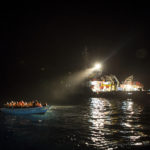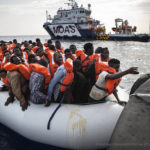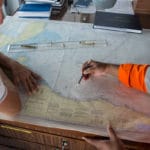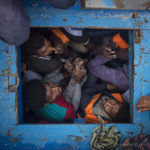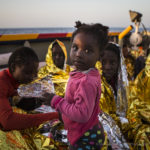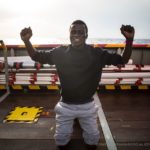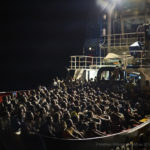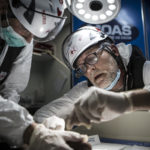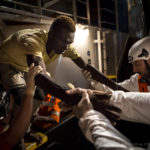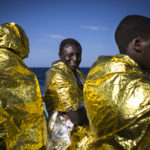Migrants don’t launch off the Libyan coast during the day. It’s more like midnight. When the waves are low and winds are gentle, smugglers crowd 100, 200, 300 souls into wooden boats or rubber dinghies. Due north.
Over the next hours, the moon dominates. Silence. Then, panic. This isn’t what any of them envisioned when they left Nigeria, Bangladesh, Syria, Mali. Some people will end up dying in the Mediterranean Sea (more than 3,600 so far this year). Others will be rescued. For the crew aboard the Responder rescue vessel—where I just lived for three and a half weeks—every hope and fear of the passengers is illuminated by a single search light. Once safely aboard the Responder, here are some of the things they told me:
“We are the lucky ones.”
There’s no dependable estimate for how many migrants perish in the Sahara Desert on their way to the Libyan coast, but that crossing may be even more dangerous than the Mediterranean. Many told me of starvation, dehydration, violence, and sexual assault in the desert. Once in Libya, nearly everyone I spoke with had been kidnapped and their families extorted for money. It’s practically a miracle they made it to the Libyan coast alive.
“There was no turning back.”
It takes more than 24 hours aboard the Responder to get from the rescue zone (just outside of Libyan waters) to Sicily, so the migrants aboard have a lot of time to think. Once reality settles in, many of them come to terms with how fortunate they are to be alive and how dangerous their journey has been. Some of them were forced to leave the Libyan coast at gunpoint. Others realize how big the Mediterranean is and come to understand that smugglers lied to them—leaving an entire boatload of people to die in the sea. One young man from Mali told me that he hadn’t felt this safe for a long time. He fled civil war in his home country and was able to get a good night’s sleep for the first time in a long time.
“I did not take this journey for me. It’s for her. I want better for her.”
It’s not uncommon for a screaming baby to be the first person rescued from a vessel in distress. We spent time on board with a 2-year-old who charmed us all. Her name was Good News and her parents dressed her in a floaty swimsuit for the journey. They knew it wouldn’t buy much time if she ended up in the water. But the possibility—of safety and a better life for their child—was worth it.
“I had a gun held to my head five times in the past three years.”
For some, the horrors in Libya mirror or surpass the violence they faced back home. Forced labor and sexual slavery of migrants are rampant. Once evening, when the Responder made a slight change in course on the way to Sicily, someone called me over with a look of intense worry. “Are you taking us back to Libya?”
“No, we’re not taking you back to Libya,” I uttered. “I promise.”
“Can I brush my teeth?”
Not all the children were fortunate enough to be on the migratory route with parents (or guardians, aunts, cousins, or even friends). I met kids as young as 11 trying to reach Europe alone. Their faces held the stress of adulthood, but their hearts remained young. They asked for music; they asked to call home; and they asked to brush their teeth.
“All hope was lost, but we made it.”
People’s reactions when they board the rescue vessel are so varied. Many are shaking, crying, confused, and cold. Others put their hands in the air and shout “thank you” from the moment they step foot on the Responder. The migrants all have one thing in common: they weren’t sure they’d make it to sunrise. But they did make it. And they’re not about to lose sight of their dreams now. Most know there’s still a long road ahead, but hope, like the horizon, is in sight.
I was aboard the Responder on behalf of the International Federation of Red Cross and Red Crescent Societies.
The Red Cross Red Crescent network and Migrant Offshore Aid Station (MOAS) patrol and conduct rescue missions along the Central Mediterranean route between North Africa and Italy—where the majority of 3,600+ drownings in 2016 have occurred. Skilled MOAS rescuers conduct search and rescue. Once people are on board, a Red Cross Red Crescent team provides first aid and emergency medical care, food, water, blankets, dry clothes, child care, and basic sanitation. The Red Cross Red Crescent network can’t solve the underlying issues that force people to leave—among them conflict and violence, inequality and injustice—but we can help prevent further loss of life at sea on board the Responder and Phoenix rescue vessels. As members of the world’s largest humanitarian network, we believe that no one deserves to die at sea—regardless of race, religion, gender or visa status. The American Red Cross has contributed more than $700,000 towards addressing the migration crisis in Europe.
https://www.youtube.com/watch?v=f_YwFoif9y8&feature=youtu.be
Photos: © Mathieu Willcocks/MOAS.eu 2016, all rights reserved.

